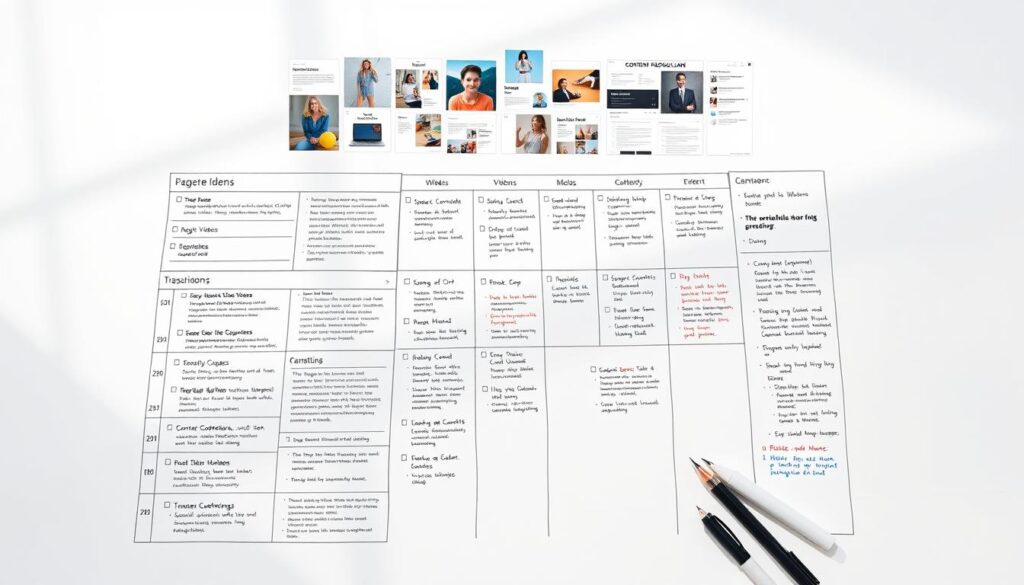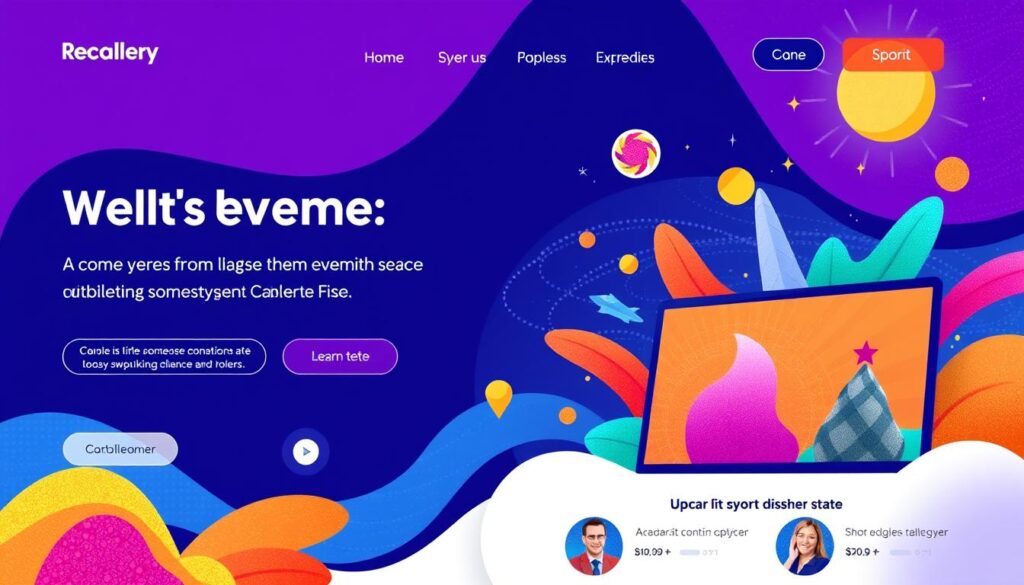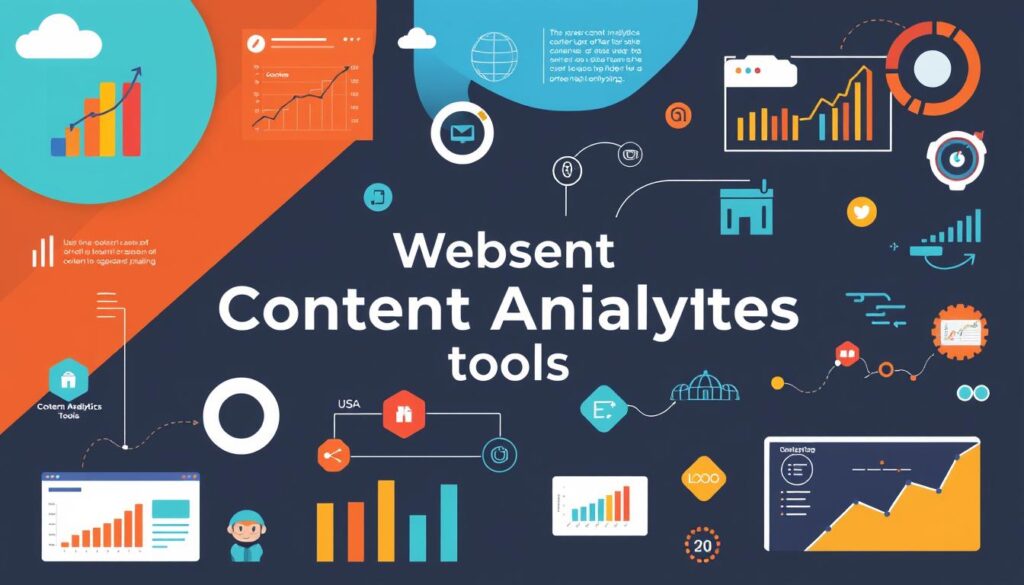In today’s competitive online landscape, high-quality content is crucial for capturing the attention of consumers and turning them into loyal customers.
Brands that invest in professional website content creation are better positioned to establish trust with their audience and drive business growth.
The relationship between engaging content and positive user experience is fundamental to digital marketing success.
By prioritising quality content creation, businesses can create meaningful connections with their target audience and enhance their online presence.
Key Takeaways
- Crafting high-quality content is vital for engaging users and driving conversions.
- Professional website content creation is essential for establishing brand authority.
- Quality content helps build trust with the target audience.
- Engaging content is crucial for a positive user experience.
- Strategic content creation enhances online presence and business growth.
Understanding the Importance of Website Content
Effective website content is the backbone of a successful online presence, influencing both users and search engines. Consumers who stumble across what you’re doing will use your content to assess whether your products, services, and identity as a company are a fit for them.
High-quality content is crucial for engaging your audience and driving business success. It not only enhances the overall experience for your visitors but also plays a significant role in determining your website‘s visibility on search engine results pages (SERPs).
Defining High-Quality Website Content
High-quality content is characterised by its relevance, accuracy, and ability to address the needs of its readers. It should be well-structured, easy to understand, and provide value to the users. By focusing on these aspects, businesses can create content that resonates with their target audience.
Impact on User Experience and Business Goals
Thoughtfully crafted content creates a seamless user journey, guiding visitors toward desired actions and ultimately contributing to the achievement of specific business objectives. By understanding how content impacts both experience and business goals, companies can develop a strategic approach to content creation that drives meaningful results.
The Fundamentals of Website Content Creation

Website content creation is a multifaceted process that requires a strategic approach to produce valuable and relevant content. It involves identifying a topic, deciding on the content format, formalizing a strategy, and producing the content.
The content creation process is not just about writing; it’s about creating assets that resonate with your target audience and drive your business goals forward.
Types of Website Content
Website content comes in various forms, including blog posts, articles, product descriptions, and more. Each type serves a different purpose and requires a unique approach to content creation.
Understanding the different types of content and their roles in your overall strategy is crucial for creating an effective content plan.
Content Creation vs Content Marketing
While content creation focuses on producing valuable assets, content marketing encompasses the distribution and promotion of that content. Both are essential for a successful content strategy.
To achieve maximum impact, it’s vital to understand the distinction between content creation and content marketing, and how they work together to drive your business objectives.
By clarifying the roles of content creation and marketing, businesses can ensure their content is not only high-quality but also effectively promoted to reach their target audience.
Developing Your Content Strategy
Developing a content strategy that resonates with your target audience is key to achieving your business goals. An effective content strategy is not just about creating content, but also about understanding the people who create and consume it, as highlighted by Kristina Halvorson, co-author of Content Strategy for the Web.
Halvorson’s framework emphasizes the importance of considering both the content and the individuals involved in its creation. This holistic approach ensures that the content meets users’ expectations and fulfils business objectives.
Setting Clear Content Objectives
Setting clear content objectives is the first step in developing a successful content strategy. These objectives should align with your overall business goals and provide a clear direction for your content creation efforts. By establishing measurable objectives, you can evaluate the effectiveness of your content and make data-driven decisions.
Identifying Your Target Audience
Understanding your target audience is crucial for creating content that resonates with them. This involves identifying their needs, preferences, and pain points. By knowing your audience, you can tailor your content to address their specific concerns and guide them through the buyer’s journey.
Aligning Content with the Buyer’s Journey
Aligning your content with the buyer’s journey is vital for driving conversions. The buyer’s journey consists of several stages, including awareness, consideration, and decision. Each stage requires distinct content approaches, formats, and calls to action. By mapping your content to each stage, you can create a seamless experience for your prospects and guide them naturally toward conversion points.
To achieve this, it’s essential to identify content gaps in your current buyer’s journey coverage and develop content pathways that address these gaps. By doing so, you can optimise the overall conversion funnel and improve the effectiveness of your content strategy throughout the entire process.
Content Ideation Techniques
The success of your content hinges on the quality of your ideas, making it essential to adopt effective ideation techniques. As a content creator, you need to stay ahead of the curve and continually produce fresh, engaging content that resonates with your audience.
Keyword Research for Content Ideas
Utilising keyword research tools is a fundamental step in generating ideas for your content. Tools like Ahrefs, SEMrush, and Moz can help identify relevant keywords and topics that are currently trending in your niche.
Customer Feedback as Content Inspiration
Listening to your customers and incorporating their feedback into your content strategy can provide valuable insights and ideas. Analyse customer reviews, comments, and surveys to understand their needs and concerns.
Competitive Content Analysis
Conducting a thorough analysis of your competitors’ content can reveal gaps in the market and opportunities to differentiate your brand. Identify areas where your competitors are lacking and create content that fills those gaps.
By employing these techniques, you can develop a robust content strategy that drives engagement and supports your business goals. Effective ideation is key to staying competitive and ensuring your content resonates with your target audience.
Creating a Content Production Plan
Establishing a robust content production plan helps in organising the content creation process. This plan is crucial for ensuring that content is produced and published consistently, meeting the desired quality standards and business objectives.

Establishing Content Governance Resources
Content governance is vital for maintaining consistency and quality across all content. Establishing clear roles and responsibilities within the team is essential. This includes defining the tasks and expectations for each team member involved in the content creation process.
To effectively govern content, it’s necessary to:
- Identify the required resources, including personnel and tools.
- Establish guidelines and standards for content creation.
- Define approval processes to ensure quality control.
Mapping Content Workflows
Mapping the content workflow is a critical step in the production planning process. It involves outlining each stage of the content creation process, from ideation to publication. By visualising the workflow, teams can identify potential bottlenecks and areas for improvement.
A well-mapped workflow enables teams to:
- Streamline the content creation process.
- Enhance collaboration among team members.
- Reduce delays and increase productivity.
Setting Realistic Timelines
Setting realistic timelines is crucial for the successful execution of a content production plan. This involves estimating the time required for each stage of the content creation process and allocating sufficient resources.
To set realistic timelines, consider:
- Estimating the time needed for research, writing, editing, and approval.
- Building buffer time into the schedule to accommodate unexpected delays.
- Regularly reviewing and adjusting timelines based on past performance.
By following these steps, teams can create a content production plan that is both effective and sustainable, ensuring that high-quality content is produced and published on time.
Crafting Compelling Website Content
Effective website content is the cornerstone of a compelling online presence that drives user engagement. It is not just about presenting information; it’s about creating a connection with your audience. To achieve this, you need to focus on developing a content strategy that resonates with your target audience.
Developing Your Brand Voice and Tone
Your brand voice and tone are essential elements in creating a consistent and engaging content experience. Developing a unique brand voice helps differentiate your business from competitors and fosters a deeper connection with your audience. It’s about being authentic and consistent in your messaging across all platforms.
Writing for Different Literacy Levels
Understanding your audience’s literacy level is crucial for creating accessible content. Simplifying complex concepts without dumbing down the information is a delicate balance. It’s essential to know your audience to tailor your content appropriately, ensuring it’s inclusive and engaging for a broad range of readers.
Creating Content That Delivers Value
To truly engage your audience, your content must deliver genuine value. This involves going beyond basic information to address the underlying needs and motivations of your users. By incorporating practical examples, case studies, and actionable advice, you can create a comprehensive context that helps users make informed decisions. Ultimately, value-driven content builds authority and trust, leading to long-term business relationships.
By mastering the art of creating content that delivers value, you can entice users to engage more deeply with your website. This could involve creating comparison guides, in-depth product demonstrations, and innovative ideas that cater to their needs. The key is to provide sufficient context that answers their questions comprehensively.
Optimising Content for Search Engines
In today’s digital landscape, optimising your content for search engines is no longer a luxury, but a necessity.

To achieve a high ranking on search engine results pages (SERPs), it’s crucial to strike a balance between creating content that satisfies search algorithms and engaging human readers. Essentially, the goal is to produce content that is helpful to your target audience, as this will have a good chance of ranking well on SERPs.
On-Page SEO Essentials for Content
On-page SEO involves several key elements that can significantly impact your content’s visibility. These include optimising meta tags, using header tags (H1, H2, H3, etc.), and incorporating relevant keywords naturally into your content. By mastering these on-page SEO essentials, you can improve your content’s search engine ranking and drive more traffic to your website.
It’s also important to ensure that your content is high-quality, engaging, and informative, as this will not only attract users but also encourage them to stay on your page, reducing bounce rates and increasing dwell time.
Balancing SEO and User Experience
While SEO is crucial for search engine visibility, it’s equally important to prioritise user experience. A well-crafted content strategy should aim to balance these two aspects. This means creating content that is not only optimised for search engines but also engaging and valuable for users. By doing so, you can improve your website’s overall performance, drive more conversions, and enhance user satisfaction.
To achieve this balance, it’s essential to regularly monitor your content’s performance using analytics tools and adjust your strategy accordingly. This will help you identify areas for improvement and make data-driven decisions to optimise your content further.
Structuring Content for Maximum Impact
A well-structured content approach can significantly enhance user experience. Structuring content effectively is vital for engaging the target audience and conveying the intended message. This involves breaking down content into manageable sections and utilising metadata to improve visibility.
Breaking Content into Manageable Chunks
Breaking content into manageable chunks enhances readability and user engagement. This can be achieved by using subheadings, bullet points, and short paragraphs. By doing so, users can quickly grasp the key points and navigate through the content with ease.
- Improve readability by using clear headings.
- Enhance user engagement with concise paragraphs.
- Use bullet points to highlight key information.
Using Metadata to Enhance Content Visibility
Metadata plays a crucial role in enhancing content visibility. By providing additional context about the content, metadata helps search engines and other applications better understand and categorise web page content. This, in turn, can improve the search engine ranking and make the content more discoverable.
| Type of Metadata | Description | Example |
|---|---|---|
| Title Tag | Defines the title of the page | “Structuring Content for Maximum Impact” |
| Meta Description | Provides a summary of the page content | “Learn how to structure content for better user engagement.” |
| Keyword Tag | Lists the relevant keywords for the content | “content structure, metadata, search engine optimisation” |
By understanding and implementing these strategies, creators can significantly improve the impact of their content on the target audience.
Visual Elements in Website Content Creation
Effective website content creation relies heavily on the integration of compelling visual elements. Visual content plays a pivotal role in enhancing the overall user experience on your website.

Visual elements such as images, infographics, and videos can significantly enhance user engagement. Incorporating these elements can make your content more appealing and interactive.
Incorporating Images and Infographics
Images and infographics are powerful tools for communicating complex information in an easily digestible format. When selecting images, it’s crucial to choose high-quality visuals that align with your brand’s messaging and resonate with your target audience.
Infographics, in particular, offer a unique opportunity to present data and statistics in a visually engaging manner, making it easier for users to understand and retain the information.
Video Content Creation Basics
Video content has become an indispensable component of a successful content strategy. To create effective video content, it’s essential to understand the fundamental principles of video creation, including planning, scripting, and structuring your videos to maintain viewer attention.
Understanding the technical basics of video production is also crucial to ensure professional quality without excessive investment. Different video formats, such as tutorials and testimonials, serve distinct purposes in your content strategy.
By exploring these different formats and understanding when to use them, you can optimise your videos for various platforms while maintaining consistent brand messaging.
Content Creation Tools and Resources
Leveraging the best content creation tools can significantly enhance the overall content production process. By automating as much of the process as possible, teams can increase collaboration, boost productivity, and save time.
Discover how specialised collaboration tools can transform content production from a linear process to a dynamic team effort.

Content Management Systems
A robust Content Management System (CMS) is essential for managing and publishing content efficiently. It allows teams to collaborate on content creation, review, and approval, streamlining the workflow. Popular CMS options include WordPress and Drupal, which offer a range of customisable features and integrations.
Writing and Editing Tools
Effective writing and editing tools are crucial for producing high-quality content. Tools like Grammarly and Hemingway Editor help refine writing, improve clarity, and reduce errors. For more complex content projects, tools like ProWritingAid offer advanced suggestions for improvement.
For more insights on content creation tools, visit Sendible’s guide on content creation tools for social.
Collaboration and Workflow Tools
Collaboration and workflow management tools are vital for coordinating team efforts and ensuring a smooth content production process. Tools like Trello and Asana enable teams to track progress, assign tasks, and meet deadlines, ultimately saving time and improving overall productivity.
Building a Content Team
In the realm of content creation, having a dedicated team is essential for driving business growth. A well-structured content team can significantly enhance a company’s ability to produce high-quality content that resonates with its target audience.
To build an effective content team, it’s crucial to understand the various roles and responsibilities involved in content creation. This includes content strategists, writers, editors, and designers, each playing a vital role in the content development process.
Key Roles in Content Creation
Identifying the right roles and responsibilities is fundamental to creating a cohesive content team. Key roles include:
- Content strategists who develop the overall content strategy
- Writers who create engaging content
- Editors who refine and polish the content
- Designers who visualize the content
In-House vs Outsourced Content Creation
When it comes to content creation, businesses often face the decision of whether to keep it in-house or outsource it. Both approaches have their advantages and disadvantages.
Keeping content creation in-house allows for better control over the content and ensures that it aligns with the company’s brand voice. However, it requires significant resources and investment in talent acquisition and training.
On the other hand, outsourcing content creation to agencies or freelancers can provide access to specialized skills and expertise, offering flexibility and scalability. It’s essential to weigh the costs and benefits of each approach and consider a hybrid model that combines the strengths of both.
For businesses looking to expand their services, such as becoming an agency to manage clients with good content and SEO services, partnering with a White Label SEO provider can be a viable option. This allows businesses to offer SEO services without the need to hire specialized staff or invest in individual tools.

Content Distribution and Promotion
A well-planned content distribution strategy can significantly enhance your online presence. Effective distribution ensures that your content reaches the intended audience, driving engagement and conversions.
Multi-Channel Content Distribution Strategies
To maximise your content’s reach, it’s essential to employ multi-channel distribution strategies. This involves sharing your content across various platforms, including social media, blogs, and video sharing sites. By doing so, you can tap into different audience segments and increase your brand’s visibility.
- Utilise social media platforms to share your content and engage with your audience.
- Publish your content on relevant blog sites to reach a wider audience.
- Leverage video sharing platforms to distribute your video content.
Repurposing Content Across Platforms
Repurposing content is a valuable technique for extending the lifespan of your content and maximising its ROI. By converting your existing content into different formats, such as turning a blog post into a video or infographic, you can reach new audiences and reinforce your message across different platforms.
- Transform successful blog posts into engaging videos or informative infographics.
- Break down comprehensive content into platform-specific micro-content.
- Repurpose content to suit different media channels, ensuring it remains relevant and engaging.
By adopting these strategies, you can significantly improve your content ROI while reducing production demands.
Measuring Content Performance

To gauge the effectiveness of your content, it’s crucial to measure its performance using the right analytics tools. After publishing your content, monitoring its performance is essential to understand its impact.
Tools like Google Search Console and rank-tracking platforms provide valuable insights into how your content is performing on search engines. The Conductor platform, for instance, offers detailed analysis, including ranking positions, organic traffic, and areas for improvement.
Key Performance Indicators for Content
To effectively measure content performance, it’s vital to track key performance indicators (KPIs). These may include metrics such as page views, engagement rates, and conversion rates. By monitoring these KPIs, you can gain a deeper understanding of how your content is resonating with your audience.
Mastering the art of translating analytics data into actionable insights is crucial for improving your content strategy. This involves identifying patterns and trends in content performance that reveal audience preferences.
Using Analytics to Improve Content Strategy
Analytics data can be used to inform and refine your content strategy. By conducting meaningful content experiments with clear hypotheses and measurable outcomes, you can identify areas for improvement and opportunities for growth.
Techniques such as competitive content analysis can help benchmark your performance against industry standards, while identifying content gaps can reveal new opportunities to engage your audience.
Common Content Creation Mistakes to Avoid
Creating a well-crafted content strategy is essential for businesses online. A successful strategy involves understanding your target audience and creating content that resonates with them.
When it comes to content creation, there are several common mistakes that businesses should avoid. One of the most significant errors is writing for everyone instead of your target audience.
Writing for Everyone Instead of Your Target Audience
Understanding your target audience is crucial for creating effective content. When you write for everyone, your message becomes diluted, and you risk losing the interest of your intended audience. By focusing on your target audience, you can tailor your content to their needs and preferences.
Neglecting Content Distribution
Another common mistake is neglecting content distribution. Creating content is only half the battle; you also need to ensure that it reaches your target audience. This can be achieved through various channels, including social media, email newsletters, and search engine optimisation.
Failing to Update Existing Content
Failing to update existing content can also have negative consequences. Over time, your content may become outdated, which can impact your website‘s credibility and search engine rankings. Regularly reviewing and updating your content can help maintain its relevance and effectiveness.
A content audit can help identify areas for improvement and ensure that your content remains relevant and effective over time. By regularly reviewing your content, you can identify opportunities to refresh and update it, improving its overall impact.
| Content Creation Mistake | Consequence | Solution |
|---|---|---|
| Writing for everyone | Diluted message, lost audience interest | Focus on target audience |
| Neglecting content distribution | Limited content reach | Utilise multiple distribution channels |
| Failing to update existing content | Outdated content, impacted credibility | Regularly review and update content |
Conclusion
Effective website content creation is a multifaceted process that requires careful planning, creativity, and a deep understanding of your target audience. To achieve the ultimate goals of a web content strategy, the finer details need to be considered.
A well-crafted content strategy strengthens your brand image through consistent voice and tone, while robust processes build a solid brand identity. By keeping language clear and concise, you’ll find that both users and search engines reward you for it.
As we reflect on the transformative power of strategic website content creation, it’s clear that it’s about building meaningful connections with your audience. A comprehensive approach creates a sustainable content ecosystem, rather than isolated pieces. Exceptional content creation is both an art and a science, requiring creativity balanced with strategic methodology.
Investing time in proper content planning and governance ultimately saves resources while improving outcomes. It’s essential to view content not as a marketing expense, but as a valuable business asset that appreciates over time. By embracing the iterative nature of content creation, where measurement and refinement drive continuous improvement, you can ensure long-term success.
Behind every successful content strategy is a dedicated team working collaboratively toward shared objectives. By implementing even a few of the best practices outlined in this guide, you can significantly enhance your website’s effectiveness. In the digital landscape, quality content remains the most powerful way to differentiate your brand.
Take the first step toward transforming your website content today, knowing that the journey brings both immediate and long-term rewards. By doing so, you’ll be well on your way to creating a robust online presence that resonates with your target audience and drives business growth.






